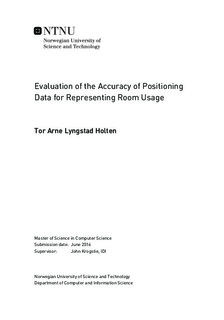Evaluation of the Accuracy of Positioning Data for Representing Room Usage
Master thesis
Permanent lenke
http://hdl.handle.net/11250/2404042Utgivelsesdato
2016Metadata
Vis full innførselSamlinger
Sammendrag
Norwegian University of Science and Technology (NTNU) is a large university consisting of several campuses, all containing many buildings and a variety of rooms. As a result of this magnitude it is challenging for facility managers to properly monitor and manage all building resources in the most advantageous approach. Since it's launch in 2011, MazeMap has helped both students and staff at NTNU to reach their destinations by providing means of outdoor and indoor navigation capabilities. In addition to being an application, MazeMap is also the underlying infrastructure for the collection of indoor positioning data from wireless devices at campus Gløshaugen. The creators of MazeMap, Wireless Trondheim, has also developed a system called Analytics System which uses the collected positioning data in order to calculate how many devices are located in each room at Gløshaugen. The goal of this research is to investigate whether or not the data produced by the Analytics System can provide a good representation of actual room usage at campus Gløshaugen.
The research uses the quantitative research approach in order to investigate if the accuracy of the collected positioning data is sufficient in order to give a good representation of room usage. By doing measurements in various rooms at Gløshaugen by measuring how many people are in the rooms it is possible to do comparison between actual room usage and the number of devices the Analytics System have estimated. Measurements are done in different types of rooms such as lecture halls, reading rooms and computer labs.
The result of the research is that the usage data produced by the current Analytics System can't be used to give a good representation of actual room usage at Gløshaugen. The numbers produced by the system is so low that no connection can be made between the calculated number of devices there are in a room and the actual number of persons in the room. It was only possible to see a small spikes in the usage data for measurements where about 150 persons were present in the room. Various approaches to improve the current Analytics System are suggested.
